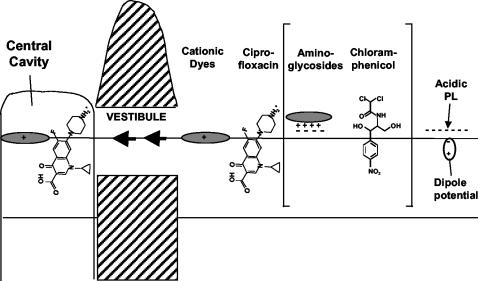FIG. 5.
Hypothetical path of substrate capture by AcrB and related pumps. The crystal structure of AcrB trimer bound to cationic dyes (44) suggests strongly that such dyes, bound to the acidic surface of the bi-layer, travel through the vestibule and bind to the wall of the central cavity without much change in its location or orientation in relation to the bi-layer surface. A similar mechanism is likely to apply for ciprofloxacin, which may partially partition into the outer leaflet of the bi-layer before diffusing through the vestibule and binding to the cavity. For the other substrates shown in the brackets, the crystal structure of the liganded AcrB is not yet available. However, it seems likely that the polycationic aminoglycosides become adsorbed to the polyanionic surface of the bi-layer and are captured by some RND pumps. Similarly, amphiphilic molecules with dipolar lipophilic domains, such as chloramphenicol, may partition partially into the outer leaflet of the bi-layer and be captured by lateral diffusion through vestibules. PL, phospholipids.

